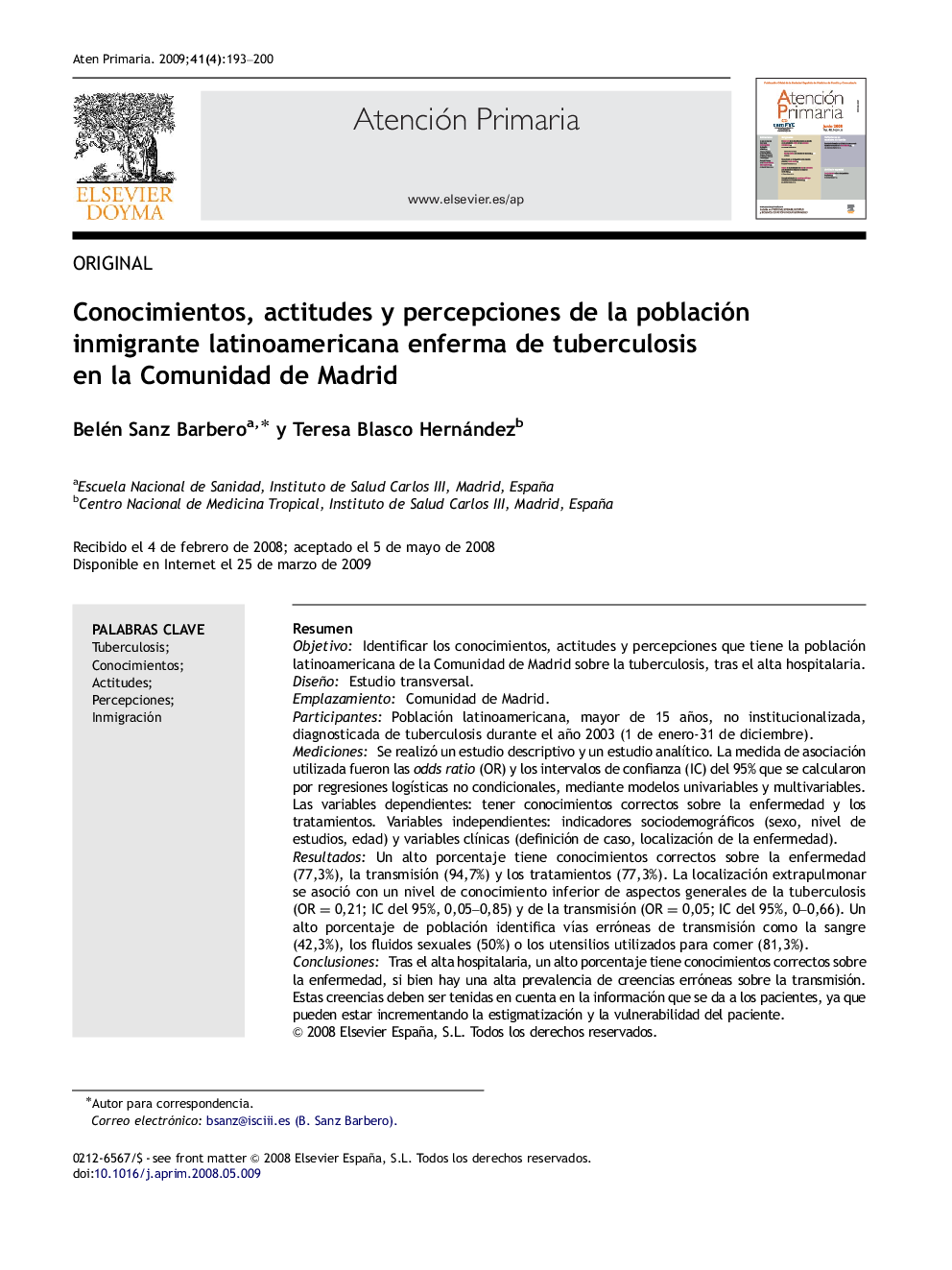| Article ID | Journal | Published Year | Pages | File Type |
|---|---|---|---|---|
| 3458142 | Atención Primaria | 2009 | 8 Pages |
ResumenObjetivoIdentificar los conocimientos, actitudes y percepciones que tiene la población latinoamericana de la Comunidad de Madrid sobre la tuberculosis, tras el alta hospitalaria.DiseñoEstudio transversal.EmplazamientoComunidad de Madrid.ParticipantesPoblación latinoamericana, mayor de 15 años, no institucionalizada, diagnosticada de tuberculosis durante el año 2003 (1 de enero-31 de diciembre).MedicionesSe realizó un estudio descriptivo y un estudio analítico. La medida de asociación utilizada fueron las odds ratio (OR) y los intervalos de confianza (IC) del 95% que se calcularon por regresiones logísticas no condicionales, mediante modelos univariables y multivariables. Las variables dependientes: tener conocimientos correctos sobre la enfermedad y los tratamientos. Variables independientes: indicadores sociodemográficos (sexo, nivel de estudios, edad) y variables clínicas (definición de caso, localización de la enfermedad).ResultadosUn alto porcentaje tiene conocimientos correctos sobre la enfermedad (77,3%), la transmisión (94,7%) y los tratamientos (77,3%). La localización extrapulmonar se asoció con un nivel de conocimiento inferior de aspectos generales de la tuberculosis (OR=0,21; IC del 95%, 0,05–0,85) y de la transmisión (OR=0,05; IC del 95%, 0–0,66). Un alto porcentaje de población identifica vías erróneas de transmisión como la sangre (42,3%), los fluidos sexuales (50%) o los utensilios utilizados para comer (81,3%).ConclusionesTras el alta hospitalaria, un alto porcentaje tiene conocimientos correctos sobre la enfermedad, si bien hay una alta prevalencia de creencias erróneas sobre la transmisión. Estas creencias deben ser tenidas en cuenta en la información que se da a los pacientes, ya que pueden estar incrementando la estigmatización y la vulnerabilidad del paciente.
ObjectiveTo identify the knowledge, attitudes and perceptions held by the Latin-American population on tuberculosis, after being discharged from hospital in the Community of Madrid.DesignCross-sectional study.SettingCommunity of Madrid.ParticipantsNon-institutionalised Latin-American population over 15 years old, diagnosed with tuberculosis during the year 2003 (1st January-31st December).MeasurementsA descriptive study and an analytical study were performed. The measure of association used was the odds ratio (OR) and 95% confidence intervals (95% CI), which were calculated by unconditional logistic regressions, using univariate and multivariate models. The dependent variables: to have correct knowledge of the disease and its treatments. Independent variables: sociodemographic indicators (sex, education level, age) and clinical variables (case definition, location of the disease).ResultsA high percentage had correct knowledge of the disease (77.3%), its transmission (94.7%) and treatment (77.3%). An extra-pulmonary location was associated with a lower level of knowledge of the general characteristics of tuberculosis [OR (95% CI), 0.21 (0.05–0.85)] and its transmission [OR (95% CI) 0.05 (0–0.66)]. A high percentage of the population identified erroneous transmission routes, such as blood (42.3%); sexual fluids (50%), or utensils used for eating (81.3%).ConclusionsAfter hospital discharge, a high percentage has correct knowledge about the disease, although there is a high prevalence of erroneous beliefs on its transmission. These beliefs must be taken into account in the information given to patients, since it could increase the stigmatisation and vulnerability of the patient.
